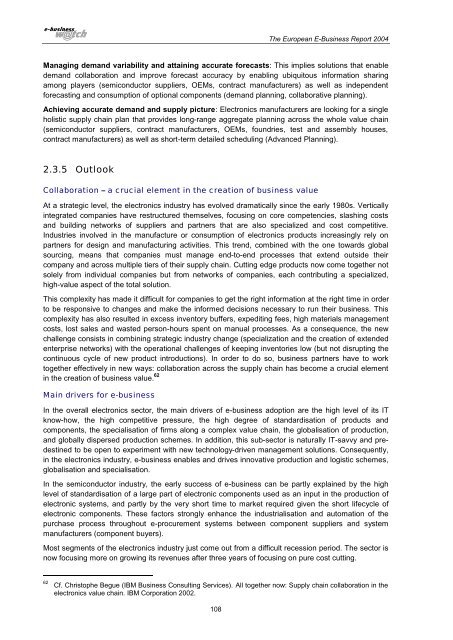The European e-Business Report 2004 - Berlecon Research GmbH
The European e-Business Report 2004 - Berlecon Research GmbH
The European e-Business Report 2004 - Berlecon Research GmbH
You also want an ePaper? Increase the reach of your titles
YUMPU automatically turns print PDFs into web optimized ePapers that Google loves.
<strong>The</strong> <strong>European</strong> E-<strong>Business</strong> <strong>Report</strong> <strong>2004</strong>Managing demand variability and attaining accurate forecasts: This implies solutions that enabledemand collaboration and improve forecast accuracy by enabling ubiquitous information sharingamong players (semiconductor suppliers, OEMs, contract manufacturers) as well as independentforecasting and consumption of optional components (demand planning, collaborative planning).Achieving accurate demand and supply picture: Electronics manufacturers are looking for a singleholistic supply chain plan that provides long-range aggregate planning across the whole value chain(semiconductor suppliers, contract manufacturers, OEMs, foundries, test and assembly houses,contract manufacturers) as well as short-term detailed scheduling (Advanced Planning).2.3.5 OutlookCollaboration – a crucial element in the creation of business valueAt a strategic level, the electronics industry has evolved dramatically since the early 1980s. Verticallyintegrated companies have restructured themselves, focusing on core competencies, slashing costsand building networks of suppliers and partners that are also specialized and cost competitive.Industries involved in the manufacture or consumption of electronics products increasingly rely onpartners for design and manufacturing activities. This trend, combined with the one towards globalsourcing, means that companies must manage end-to-end processes that extend outside theircompany and across multiple tiers of their supply chain. Cutting edge products now come together notsolely from individual companies but from networks of companies, each contributing a specialized,high-value aspect of the total solution.This complexity has made it difficult for companies to get the right information at the right time in orderto be responsive to changes and make the informed decisions necessary to run their business. Thiscomplexity has also resulted in excess inventory buffers, expediting fees, high materials managementcosts, lost sales and wasted person-hours spent on manual processes. As a consequence, the newchallenge consists in combining strategic industry change (specialization and the creation of extendedenterprise networks) with the operational challenges of keeping inventories low (but not disrupting thecontinuous cycle of new product introductions). In order to do so, business partners have to worktogether effectively in new ways: collaboration across the supply chain has become a crucial elementin the creation of business value. 62Main drivers for e-businessIn the overall electronics sector, the main drivers of e-business adoption are the high level of its ITknow-how, the high competitive pressure, the high degree of standardisation of products andcomponents, the specialisation of firms along a complex value chain, the globalisation of production,and globally dispersed production schemes. In addition, this sub-sector is naturally IT-savvy and predestinedto be open to experiment with new technology-driven management solutions. Consequently,in the electronics industry, e-business enables and drives innovative production and logistic schemes,globalisation and specialisation.In the semiconductor industry, the early success of e-business can be partly explained by the highlevel of standardisation of a large part of electronic components used as an input in the production ofelectronic systems, and partly by the very short time to market required given the short lifecycle ofelectronic components. <strong>The</strong>se factors strongly enhance the industrialisation and automation of thepurchase process throughout e-procurement systems between component suppliers and systemmanufacturers (component buyers).Most segments of the electronics industry just come out from a difficult recession period. <strong>The</strong> sector isnow focusing more on growing its revenues after three years of focusing on pure cost cutting.62Cf. Christophe Begue (IBM <strong>Business</strong> Consulting Services). All together now: Supply chain collaboration in theelectronics value chain. IBM Corporation 2002.108
















